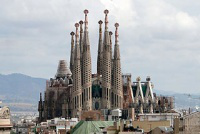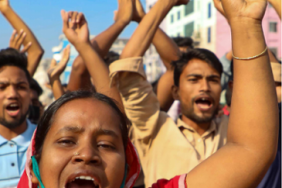Vatican: exhibition on Gaudi and Sagrada Familia

La Sacrada Familia
An exhibition on the architect Gaudi and his 'Sagrada Familia' Cathedral in Barcelona opened today in the Charlemagne Wing of Bernini's colonnade around St Peter's Square. The exhibition will remain open until 15 January 2012.
The exhibition was presented this morning by Cardinal Lluis Martinez Sistach, archbishop of Barcelona, Spain; Cardinal Gianfranco Ravasi, president of the Pontifical Council for Culture; Joan Rigol of the 'Fundacio Junta Constructora de la Sagrada Familia'; Fr Antoni Matabosch, honorary president of the 'Fundacio Joan Maragall'; Daniel Giralt-Miracle, curator of the exhibition, and Cecilia Pereira, representative of the Spanish Cultural Action Agency (AC/E)
"The consecration of the basilica of the 'Sagrada Familia' on 7 November 2010 was a historic moment for the city of Barcelona", said Cardinal Martinez Sistach. "That year we completed the interior of this beautiful and unique church, the building of which began in 1882 and, in 1883, was put into the hands of the young and innovative architect Antoni Gaudi. ... The aim of this exhibition, then, is to express our recognition to the Holy Father, to the Pontifical Council of Culture and to the Pontifical Council for Promoting New Evangelisation for the interest and sensitivity they have shown for the basilica of the 'Sagrada Familia' and for Antoni Gaudi, the 'architect of God'".
"The exhibition we are presenting ... is another of the contributions of Christian faith which the Church has made over the centuries to the world of culture, art and beauty. It highlights the beauty, majesty and symbolism of this magnificent church standing at the centre of the great metropolis of Barcelona. As Benedict XVI said when he visited the city, this basilica is a visible sign of the invisible God, so necessary in our Western European societies with their prevailing secular culture and religious indifference.
... Gaudi was a Christian in word and in action, ... and building the 'Sagrada Familia' helped him in his own personal conversion. We must see him not just as an architectural genius but above all as an exemplary Christian. Let us all pray to the Lord that a miracle may come about through Gaudi's intercession, that he may be declared a blessed".
Daniel Giralt-Miracle, explained that the exhibition is divided into three sections: art science and spirituality. The first of these "immerses visitors in the aesthetics of Gaudi, surrounding them with his colours, forms spaces and the various artistic techniques he used in his works". The second section outlines the technical aspects of the building of the 'Sagrada Familia', while the third covers "the direct allusions to the Christian religion which Gaudi included in his church", with a series of drawings for the facade of the building and designs for the stained glass windows.
Joan Rigol explained how "Gaudi's architecture developed in the very specific context of the Catalan cultural renaissance between the nineteenth and twentieth centuries. ... The aspiration of Gaudi's generation was to give backbone to a people through the personalising values of culture. ... The Church has always made an essential contribution to the formation of culture and art as an expression of the spiritual values of a community of people, also in Catalonia".
Finally Fr Antoni Matabosch noted that "today the proposal made by Cardinal Ravasi to the 'Fundacio Joan Maragall' becomes a reality: ... that of organising an event in Rome to express the cultural dimension of the Church in Catalonia".
He also explained that the exhibition will be accompanied by a number of institutional and academic gatherings, including a debate on the theme "Architecture: Symbolism and Sacredness. A Century after Gaudi", to take place at the MAXXI in Rome on 12 December, and a concert by the "Escolania de Monserrat" at the Basilica of St Mary Major on 13 January 2012.
Source: VIS


















